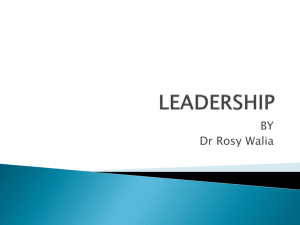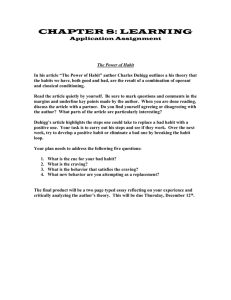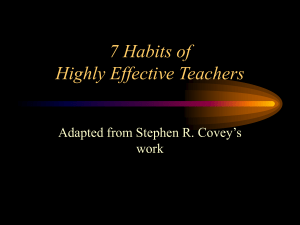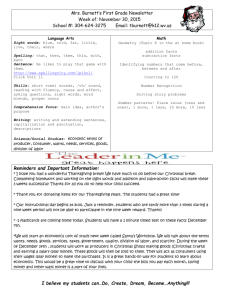Recent Theories of leadership
advertisement
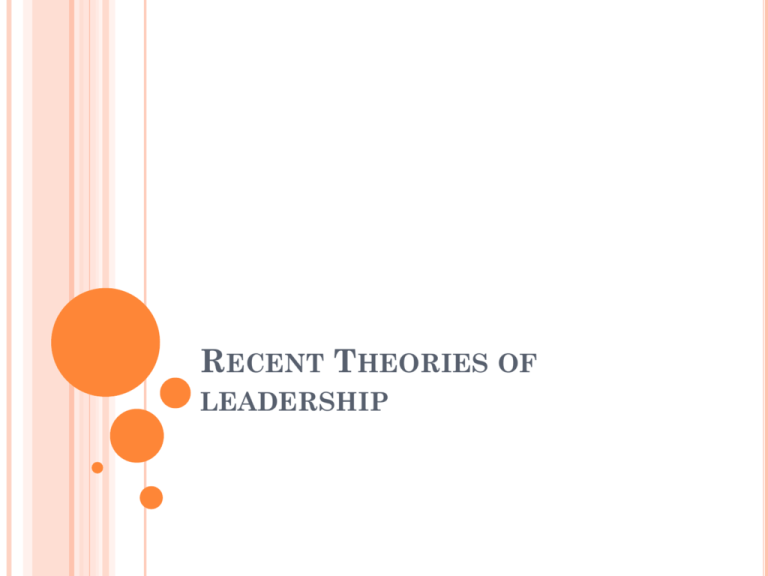
RECENT THEORIES OF LEADERSHIP SEARCH FOR EXCELLENT Tom Peters and Robert H. Waterman’s In Search of Excellent (1982). The basic theme of this body of work is familiar-to succeed leaders must attend to both the hard and soft components of the organization (the tasks and the people). The eight attributes of successful leadership are as below. Bias For Action. 1. A preference for doing something-anything-rather than sending an idea through endless cycles of analyses and committee reports. Staying Close To The Customer 2. Learning customer preference and catering to them. Autonomy And Entrepreneurship 3. Breaking the corporation into small companies and encouraging them to think independently and competitively 2 Productivity Through People Hands-on, Value-driven Creating in all employees the awareness that their best efforts are essential and that they will share in the rewards of the company's success. Insisting that executives keep in touch with the firm’s essential business and promote a strong corporate culture Stick To The Knitting Remaining with the businesses the company knows best Simple Form, Learn Staff Few administrative layers, few people at the upper levels. Simultaneous Loose-tight Properties Fostering a climate in which there is dedication to the central values of the company combined with tolerance for innovation from all employees who accept those values 3 Source: attributes of leadership as specified from In Search of Excellent Peters promotes the importance of organizations being responsive to customer needs and supporting experimentation, initiative, and risk taking to accomplish goals and satisfy highly visible customers. The research stresses the importance of rich, in-formal communication, open forums, management by walking around(MBWA), positive reinforcement, better listening, constancy of innovation, and responsiveness to customer and employees. Mistakes are always viewed as progress, although they must be identified and corrected quickly. Peter’s message is listening, trust, respect, and innovation. Leaders must love change (instead of fighting it) and instill and share an inspiring vision. 4 THE 7 HABITS OF HIGHLY EFFECTIVE PEOPLE (STEVEN R COVEY BOOK 1989) Habit Take the initiative, responding and making things happen. Realize you have freedom to choose, be aware of self, develop knowledge and integrity in choice. Habit 1: Be Proactive. 2: Begin with the End in Mind Start with an image or paradigm of the end in mind. Have a clear understanding of where you are going, where you are, and what it is going to take to get the destination. Leadership comes first. 5 Habit Practice effective self-management day in and day out. Discipline comes from within and is measured by personal integrity. All truly successful people make present decisions that help achieve desired outcomes. Organize your time and tie weekly goals to your principles, priorities, and vision. Habit 3: Put First Things First 4: Think Win/Win Have a frame of mind that always seeks to have all parties feel as though they have won-the benefits to be mutually shared. All parties feel good about decisions made and are committed to the plan of action. 6 Cooperation is the key. Habit 5: Seek First to Understand, Then Be Understood Habit 6: Synergize Practice empathetic listening skills so th at you understand other people from their frame of reference. Listen with not only ears, but with eyes and hearts. Then, present your ideas logically, clearly, specifically, and in the context of understanding the other person. Create new alternatives. Leave your comfort zones to confront new and unknown challenges. Value differences, respect them, and use them to build on strengths. Discard old scripts, and write new one. You are limited only by your own imagination. Develop unity and creativity with others. Unleash new powers, create new, exciting alternatives. Habit 7: Sharpen the Saw Take time to preserve the most important asset-yourself. Take time to minister to your own physical, mental, social/emotional, and spiritual needs. Leading people requires a tremendous amount of energy. Make a constant effort to manage health needs. Model good self-help technique. Convince others that they are valued and should valued 7 others. Enjoy and celebrate accomplishment. THE LEARNING ORGANIZATION The “learning organization” concept developed by Peter Senge (1990) is a generative process that enhances and extends an organization’s ability to create. The concept of responsiveness is an important organizational behavior, but the real payoffs come from being generative. Clarify what is important by continually learning how to see the current reality more clearly and developing abilities to move beyond it. This new learned knowledge permeates the organization and gives coherence to diverse activities. A shared vision provides the focus and energy for learning and creates commitment (not compliance). Commitment to the vision fosters risk taking and experimentation. It is central to the daily work of those within the organization. Effective leaders help their employees to understand the systematic forces that shape change and to see current reality. Effective leaders instill the confidence in their employees that together “We can learn whatever we need to learn in order to achieve the results we truly 8 desire” (Senge, 1990. p. 399) TOTAL QUALITY MANAGEMENT (TQM) Edward Deming (1986,1991,1993), the father of TQM, stated, “Workers are responsible for only 15% of the problems, the system for the other 85%”. He then added that the system is the responsibility of management. The heart of Deming’s approach to improving the organization is teamwork and collaboration among managers and workers. The leader provides core values, consistency of purpose, information, support, training, integration, common language, continuing feedback, improved systems, alignment, integrity, time, trust, and resources. Employees are responsible for improving themselves and the work process in such a way that the outcomes of the organization continuously improve. 9 TQM applied to education includes commitment to aims and purpose, a shared common vision; accountability and testing designed to improve and reduce cost; continuous improvement of schools; developmental plans and training for all employees; and, the development of leadership and pride in what employees do. Fear is eliminated so that people feel free to ask questions, take a stand, make suggestions, experiment, and take risks. Leaders must build the culture within the organization to support the needed transformation. Deming provides a number of statistical models and theories to organize and present information in order to improve and streamline communication, such as action plan, brainstorming, cause and effect analysis, flowchart, histogram etc. 10 SCHOOL-BASED MANAGEMENT (SBM) School-based or site –based leadership follows many of the same principles as total quality leadership. It empowers staff to create condition in schools that facilitate improvement, innovation, and continuous professional growth (David, 1989). It gives the school principal and professional staff members the widest possible latitude in sustaining efforts to continuously improve the effectiveness of the teaching and learning process. Teachers would be encouraged to introduce improvements that directly affect teaching and learning and that require genuine authority over budget, personnel, curriculum, instruction, and program evaluations. The probability to success is increase when school staff have time to acquire new knowledge and skill. Participants are rewarded for the progress they make towards the shared goals and vision.11 CULTURAL LEADERSHIP Schein (1985) suggest that the most important thing that leaders do is help shape an effective culture in which people will complete their work. In fact, culture is often defined as “the way we do things around here”. Deal and Kennedy (1982) suggest that culture gives meaning to work, providing an understanding of how the organization moves from desired values and outcomes to work performance and finally to actual results. It is the internal system of organizational integration. Lee G. Bolman and Terrence E. Deal (1991) believe that; 12 Culture is both product and process. As product, it embodies the accumulated wisdom of those who were members before we came. As process, it is continually renewed and recreated and new members are taught the old ways and eventually become teachers themselves. Our view is that every organization develops distinctive beliefs and patterns over time. Many of these patterns and assumptions are unconscious or taken for granted. They are reflected in myths, fairy tales, stories, rituals, ceremonies, and others symbolic forms. Managers who understand the power of symbols have a better chance of influencing organizations than do those who focus only on other frames. Perhaps the cultural glue that holds organizations together is trust. 13 TRANSFORMATIONAL LEADERSHIP Burns (1978) proposed “transactional” and “transformational” leadership. “Transactional” leadership is based on defining needs, assigning clear tasks, rewarding congruent behavior, and having a command-and-control mentality. Followers are willing to trust the leader because they need to have problems solved and they believe the leader can solve them. “Transformational” leaders develop followers, help map new directions, mobilize resources, facilitate and support employees, and respond to organizational challenges. They see change as necessary and strive to cause it. 14 Transformational leaders create the incentives for people to continuously improve their practices and, thus, those of the organization. Transformational school leader are in continuous pursuit of three fundamental goals: 1. 2. 3. Helping staff members develop and maintain a collaborative, professional school culture. Fostering teacher development, and Helping teachers solve problems together more effectively 15 Transformational leaders provide the mechanism by which solution are transferred into subsequent practice by building the capacity of the individuals and the group. Transformational leadership is a process to shape and elevate goals and abilities so as to achieve significant improvements though common interest and collective actions (Bennis & Nanus, 1985). Successful leaders expend extraordinary efforts to achieve goals through: 1. 2. 3. 4. Vision- knowing your desired outcomes and methods of achievement through lots of idea development and the creation of vision Communication- expressing your ideas through various forms of presentation, including symbolic actions and shared meaning. Trust-being predictable, accountable, persistent, and reliable and having integrity. Deployment- knowing and nurturing of strengths, compensating for weaknesses, evaluating in relation to job requirements, and focusing on16 positive goals not problems. EMERGING LEADERSHIP PERSPECTIVES Rujukan : Schermerhorn J.R., Hunt J.G., and Osborn R.N.(2008). Organizational Behaviour 10/E Chapter 12 1. Integrative Leadership 2. Moral Leadership 3. Full-range leadership theory (FRLT) Shared Leadership Cross-Cultural Leadership: Project GLOBE strategic Leadership Ethical Leadership Authentic Leadership Servant Leadership Spiritual leadership Change Leadership Leaders as Change Agents Phases of Planned Change Planned Change Strategies Resistance to Change 18

